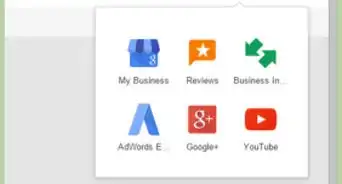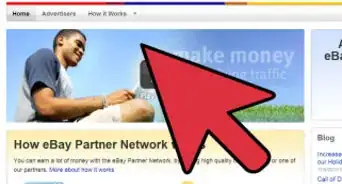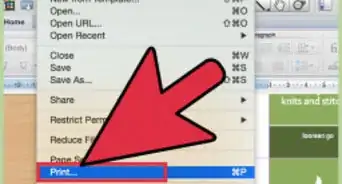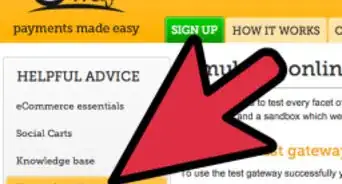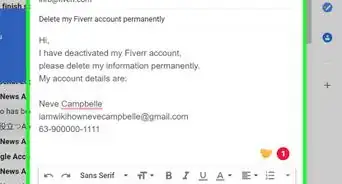wikiHow is a “wiki,” similar to Wikipedia, which means that many of our articles are co-written by multiple authors. To create this article, 55 people, some anonymous, worked to edit and improve it over time.
There are 10 references cited in this article, which can be found at the bottom of the page.
This article has been viewed 148,600 times.
Learn more...
Generating leads is a vitally important part of the sales process. Marketers should be able to collect leads through a variety of methods, both online and off, in order to find more potential clients. Your goal should be to collect as many email addresses and phone numbers as possible. Take a look at the following steps to help you generate leads.
Steps
Using Websites
-
1Create a website that can capture leads. Your website should be easy to navigate and have information about your company and its products or services. Capture customer information through a form that asks them questions about their needs. A price quote form is a good way to do this. You'll receive an email with the potential customer's contact information.
- Make sure your website is listed with major search engines, such as Google, Yahoo, and Bing. This is the bare minimum for being noticed online. Practice searching for your site on each popular engine as well to see what comes up.
-
2Set up an email auto-responder. To sign up for an auto-responder, potential customers simply enter their email address. There are various types of auto-responder services that vary in complexity, and some are geared specifically toward generating leads. Types include welcome emails, responses based on specific online activities, and product recommendations.[1]Advertisement
-
3Promote your business on social networking sites. These sites are where millions of people are already gathering to connect with each other. So, establishing a meaningful presence there is a good idea. You can create a page on these sites to promote your business. When a customer "friends" you or "becomes a fan," the people in her network can learn about your company as well.
- Use different modes of social media. You might start with a general site like Facebook, a business networking site such as LinkedIn, or a microblogging and all-purpose site like Twitter. However, consider expanding to picture-based sites like Pinterest or Instagram. Also look for any types of social networking platforms specific to your industry, like Glozal for real estate, Lawyrs for law, or Architizer for architects and designers.
- Don’t forget about your social media. Many companies put up a social media page and then neglect to update it. Once you have a page, schedule regular weekly or daily updates. And don’t just try to amass followers; try to engage them. Use giveaways and promotions. Respond to their comments, and address any concerns in a timely manner.
-
4Conduct Search Engine Marketing (SEM) and Search Engine Optimization (SEO). SEM involves using paid ad words to drive clicks and increase traffic to your company’s website or its online promotional landing pages. SEO is a type of SEM in which you produce content that helps move your site “organically” to the top of searches for companies like yours.
- Give potential web leads something to do. When someone does arrive at your page via your SEM efforts, they should have some clear options of what to do. Make it easy for them to leave their contact information or purchase your product or service through ecommerce. Your web content management system might already have an ecommerce plugin or application, such as WordPress’ MarketPress, or you can add ecommerce capabilities through a third-party provider, such as PayPal.
-
5Track your traffic on all your web platforms. Social media sites usually have their own tracking mechanisms, or third-party apps can track your traffic for you. Pay special attention to which ad words are working for you and which aren’t, especially since you pay for those.
- Look for trends and patterns. Are there particular times of the day, week, or month that you experience more or less travel? What about the geographic regions your visitors come from? Try to figure out why. Determine which ad words give you the best bang for your buck. Also identify weaknesses. Maybe you don’t have that many followers on social media, or maybe your online sales are sluggish. This is all information you can use.
- Isolate potential leads. Notice who comments on your social media posts. Look for people who have used your coupons, taken action on your website, or replied to your newsletters. These are all people that are leads.
Using Mailing Lists and Listservs
-
1Keep multiple email lists. Since one of your goals is amassing relevant email addresses, you’ll want to keep a master list and be sure to back it up. However, not all potential leads are the same. Some addresses are from people you know and have met. Others are from strangers who may or may not be leads.
-
2Maintain a list of customers. These might be your VIPs. These are past customers and hopefully repeat customers. You can offer them special deals and special treatment, since they’re a critical part of your business.
-
3Keep a list of people who have contacted you online. These are people you have not met, or haven’t met yet, but who may be leads. Turn them from strangers into leads by enticing them with promotions that appeal to first-time customers. For example, a first month free promotion, no set-up charges, or free installation are all promotions that apply to new customers, rather than repeat ones.
-
4Become active on listservs and message boards. Listservs are applications that manage email discussion groups,[2] and message boards are online discussion areas where people discuss specific subjects and troubleshoot. Find some lists and boards that are relevant to your business. Keep track of who is active there and learn more about them and their businesses. Ask questions, and if you know the answers to someone else’s question, answer it.
-
5Send an email newsletter. An email newsletter is kind of like a more detailed social media post or a more exciting press release. Incorporate pictures, stats, quotes, and ideally try to have more than one person speaking or lending quotes to the newsletter. Include links to your site and your social media sites. Also, make some sort of call to action: take our survey, use this coupon, follow our Facebook page, etc.
Generating Press and Publicity
-
1Promote your business on news sites. Use news sites to distribute press releases concerning your business. This begins with writing a press release in which you discuss something newsworthy about your company: a new product launch, a special event, a co-branding initiative, charity work, or a high-level change in management. Use terms and language optimized for search. Also be sure to include a press contact’s name, email address, and phone number in the release.
-
2Send releases out over the wires. PR Newswire and Business Wire are well known press release distribution services. Some services charge a fee, and others are free. Look for general distribution platforms like PRWeb and Newsvine, and also industry-specific distributors or “Microlists” that deal with niches such as tech, healthcare, lifestyle, and finance.
-
3Distribute your release directly to reporters. After sending out your release over the wires, you may have gotten some attention from the press already, and may now be comfortable reaching out to the press directly. Search for reporters and editors that have written stories you like about similar articles. Reach out with an email, and follow up a day or two later with an email or phone call.
-
4Make ongoing announcements. You should obviously announce the launch of your company itself, but you can announce other launches as well. For example, you can promote the launch of a new product or service, and you can announce a re-launch, the launch of a new website, a prominent new hire, a rebrand, or the opening of a new location or office.
-
5Use your publicity. It’s okay to brag. If you’ve gotten great media coverage, or even a mention, you should proudly share your success. Even before you get press, it can be good to alert key followers that it’s coming.[3]
- Have a press tab on your website that includes copies of or links to your full articles. Pull out the best quotes from articles that speak highly of your business. You might also to an “As seen in…” graphic.
- Use press mentions in signage, handouts, and other paraphernalia you bring to trade shows. Include press hits in your email newsletters and social media posts too. Print out and frame your favorite articles to hang them on your wall.
Using Surveys
-
1Develop a survey. Put together some strategic questions for an online survey to circulate to your emailing lists. They don’t have to be elaborate or conform strictly to the scientific method. Simple surveys can still be effective.
-
2Don’t use a simple word processing document. You might be more familiar with using a word processing platform or spreadsheet, but a dedicated survey tool is better. Consider using one such as Constant Contact or SurveyMonkey that aggregates results for you.[4] These tools also have helpful features and types of surveys and questions that you might not have thought about.
-
3Develop insightful questions. Decide from the outset which type of information you’re looking to learn so you can be specific and focused. Ask the most important questions first. That way, you can get your most important topics addressed before a respondent tunes out or skips to the end.
- Make the survey user friendly and brief. Ask multiple-choice or “closed” questions: ones that can be answered with one word or phrase. This makes results easier to analyze for you, and it makes questions easier to answer for your respondents.
- Introduce some variety to your queries. You might add some yes-or-no’s to your multiple choice questions, or you could have them answer some queries on a scale of 1 to 10, for example. This might also be the exception to the rule of sticking to closed questions. You could ask an open-ended question or two for variety’s sake.
-
4Analyze your results. A good survey should help you find out what your customers really value, and may give insight into how they search for you. Then, you can place yourself on the other end of that search. Survey tools also usually provide pie charts and other graphics to help you visualize results or to use in presentations.
Leveraging Your Expertise
-
1Research your industry. Read everything you can get your hands on in your industry. Search for online articles using the same search terms your customers might use to find you. Also, read books and longer-form articles. They tend to have good citations, appendices, resource lists, and bibliographies that might inspire some leads.
-
2Use industry know-how for B2B leads. You might not be looking for consumers exclusively. With knowledge of your industry, you can also find industry leaders who might provide leads or other businesses that might be complementary to your own: buyers, suppliers, distributors, etc.
-
3Offer your own expertise. When you’re experienced in your own business sector, you might want to write articles of your own for trade publications. Authorship can put you in front of new audiences. The articles you write are also excellent self-promotion just like your press hits. Promote your authored articles as well in your emails, newsletters, social media, etc.
-
4Develop your leadership leads. Try to build on the leads you find through your thought leadership efforts, particularly if your initial interaction is online. Schedule a meeting or make a phone call. A phone call is a more personal form of communication, and it is not a generic or mass media message. Plus, it shows your potential lead that you and your company are real, and that she’d be doing business with a real person.
-
5Become a government contractor. If your company provides the types of goods and services that the government typically buys, try becoming an official government contractor and bidding on contracts. Government applications are especially relevant if your company provides a niche service or offers unique expertise. You will have to fill out a number of forms, but once you’re official, this could open up a huge new avenue of leads. Some companies’ entire business is conducted with governments.
Participating in Events
-
1Promote your company at trade shows. Set up a booth at industry-related trade shows. There, buyers and other interested parties can get more of a hands-on understanding of your business. You can find trade shows through your listservs, your industry, or through trade groups online like the Trade Show News Network.[5] Just as you want people to have something to do when they land on your webpage, give them something to do at your table as well.
-
2You can capture leads by asking those that are interested to add their email addresses to your list or fill out a postcard. Even better, leave out a fishbowl into which visitors can drop their business cards. Hold a drawing at the end of the tradeshow to give free prizes that relate to your company, like gift certificates. Be sure to have plenty of business cards of your own handy to hand out as well.
-
3Follow up after the event. Don’t forget to follow up after the show ends! Thank people for visiting, and offer to answer any questions they may have. You can add them to one of your targeted email lists, and give them online coupons.
-
4Attend industry events and meetups. Join local, national, and even international trade organizations. Look for nearby events hosted by your local chapter. You can also find potential leads by looking at clubs with interest areas relevant to your business. Look at Meetup.com,[6] for example, to search for clubs and meetups by industry and in your geographic location.
- Look for well-attended events. Sometimes an event will show an RSVP headcount, or the group will list its membership numbers. This can help you see which groups and meetups are most popular.
- Read reviews of past events, if possible. This can help you see if the events were, in fact, well-attended and well-liked. This may also help you see if the topics of the meetup match up with its the advertised title and description.
-
5Attend alumni events. Going to alumni events can be a great way to reconnect with old friends, but also a way to meet new ones that graduated before or after you. Many people switch jobs or start companies that might be a good fit with your work. They're also usually more receptive to doing business with someone from their old school.
- Find common experiences. With alumni, you can talk about a number of topics to find common ground. Ask about majors, sports and other extracurricular activities, favorite places to hang out at school, and graduation year (if it doesn’t already say it on the nametags).[7]
- Arrange to contact them after the event. Since you’ll want to follow up with any potential leads you meet, ask for a business card. You could offer yours first and then they may reciprocate, or you can initiate. Send a nice email saying you were pleased to meet them, and schedule an informational interview at their convenience, if you’d like.[8]
-
6Host events of your own. You can host your own events too, of course. They could include launch parties, anniversary parties, info sessions, or holiday parties. If you’re unsure about how to host an event, or if you have a smaller events budget, you can always co-sponsor an event. Just be sure to be realistic about your goals, to find a partner that syncs well with your brand, and to add value of your own.[9] Your company could be the food sponsor or the “brought to you by…” company, for example.
Sponsoring and Advertising
-
1Sponsor a local non-profit organization or charity. Besides being a good thing to do, sponsorship can expose you to new audiences and new leads. If your company has the budget to be a title sponsor or cosponsor, it should consider sponsoring local organizations. It might be a dance company, baseball team, or youth mentorship program. These types of sponsorships often give you access to local business and civic leaders that can provide leads.
-
2Generate leads through local advertising. Don’t forget “traditional” or offline media. You can place ads in your local newspapers or on radio stations or billboards. These ads should direct people to either call or visit your Web site. You can usually get more leads if you offer a discount or special offer, or a particular discount when someone mentions the ad.
-
3Use direct mail to entice customers. Direct mail still works for a variety of businesses. You can purchase a mailing list that fits certain specifications, such as neighborhood or income level, and send your mailing to these people. Be sure to target demographics that fit your product. The more targeted your mailing is, the greater likelihood you will receive interested leads.
Expert Q&A
-
QuestionHow do you search for good keywords?
 Ryan ConwayRyan Conway is a Marketing Expert and the Founder of Digital Tradesman, a digital marketing agency that helps builders, contractors, and tradesmen grow their business online. With over a decade of experience, he specializes in marketing, web design, and search engine optimization. Ryan holds a BS in Business Administration and Entrepreneurial Studies from Hartford University. He also studied Graphic and Web Design at the Boston University Center for Digital Imaging Arts. Ryan participated in Seth Godin’s altMBA in the winter of 2016.
Ryan ConwayRyan Conway is a Marketing Expert and the Founder of Digital Tradesman, a digital marketing agency that helps builders, contractors, and tradesmen grow their business online. With over a decade of experience, he specializes in marketing, web design, and search engine optimization. Ryan holds a BS in Business Administration and Entrepreneurial Studies from Hartford University. He also studied Graphic and Web Design at the Boston University Center for Digital Imaging Arts. Ryan participated in Seth Godin’s altMBA in the winter of 2016.
Marketing Expert To start, just write a list of just ideas of things that you want to be found for. After you do that, go to Google and type in those terms to see what comes up and check which competitors come up first. Then, you can also look for suggested terms at the bottom of the results to find out which related search terms people have also been searching for these businesses. This will help you optimize your website with great keywords. There are also more advanced tools to do in-depth keyword research, but Google is usually the best place to start.
To start, just write a list of just ideas of things that you want to be found for. After you do that, go to Google and type in those terms to see what comes up and check which competitors come up first. Then, you can also look for suggested terms at the bottom of the results to find out which related search terms people have also been searching for these businesses. This will help you optimize your website with great keywords. There are also more advanced tools to do in-depth keyword research, but Google is usually the best place to start. -
QuestionHow many leads can one generate in a month, on average?
 Sheejo GeorgeCommunity AnswerIt always varies from company to company and product to product. I am part of a company that generates more than 100 leads in a month for our own business purposes, but for other companies we provide an average of 1000 leads per month.
Sheejo GeorgeCommunity AnswerIt always varies from company to company and product to product. I am part of a company that generates more than 100 leads in a month for our own business purposes, but for other companies we provide an average of 1000 leads per month.
References
- ↑ http://mailchimp.com/features/automation/
- ↑ http://www.slate.com/articles/technology/technology/2010/08/the_joy_of_listservs.html
- ↑ http://technori.com/2013/04/4108-how-to-maximize-the-media-coverage-your-startup-gets/
- ↑ http://www.idealware.org/articles/fgt_online_surveys.php
- ↑ http://www.tsnn.com/
- ↑ http://www.meetup.com/
- ↑ https://www.themuse.com/advice/back-to-school-how-to-rock-your-next-alumni-networking-event
- ↑ https://www.careereducation.columbia.edu/resources/tipsheets/skills-networking-alumni
- ↑ http://www.fastcompany.com/3009372/4-lessons-on-using-co-branding-to-co-crush-the-competition
About This Article
One of the best ways to generate leads is to create a company website that includes a questionnaire or price quote form so that you can capture contact information from potential customers. Next, create a list of emails and send out periodic offers and newsletters to the recipients. It's also important to maintain a social media presence so that you can promote your business and engage potential customers on those platforms. For tips on using tools like search engine optimization to generate leads, read on!




-Step-3.webp)










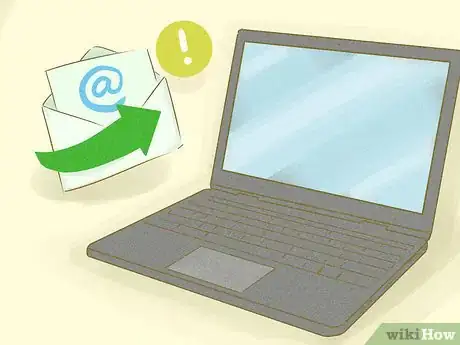









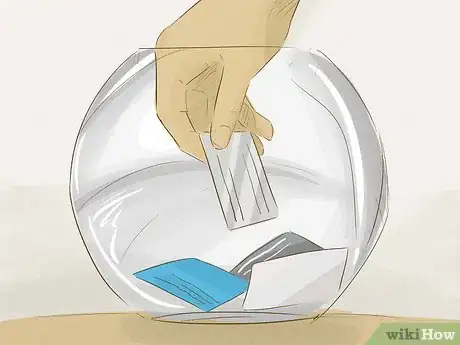



-Step-16-Version-3.webp)



